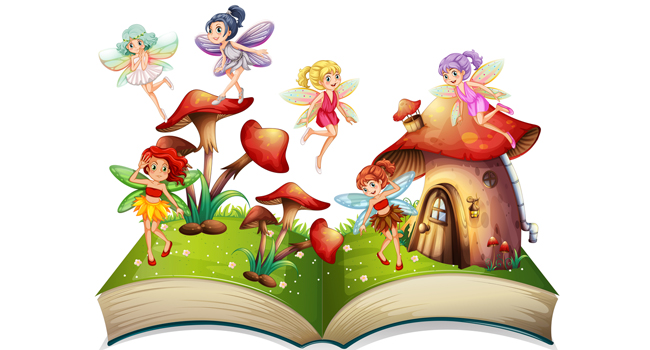Importance of Storytelling: Advantages and Tips for Parents and Teachers

I remember reading fairy tales every night under the blanket using a torch even after being warned to sleep. That was fun for many of us!
Childhood stories are still afresh in our minds as we go back in time with folklore characters like fairies, princesses, princes, goblins, giants that make up most of our childhood memories.
Fantasy stories are retold countless times and every time you are drawn back to faraway lands. Every child has an innate affection for stories. To keep the magic of storytelling, pass on these same feelings to the future generations so that they also experience the magic of storytelling.
Storytelling: An Elixir to Happy Childhood and Adulthood
Stories are a great way to tickle your senses and all of us are so fond of mysterious fairylands. Stories increase the power of remembering with greater ease and accuracy. Great stories improve the child’s linguistic skills, knowledge in a more gentle and personal way.
Your child tends to become more attentive, obedient and well-mannered. A clear and meaningful conclusion will help them to learn new things and differentiate between good and bad qualities, values or characteristics.
Researchers have proven that storytelling restores cognitive development in the child and enhances its capacity for observation, thinking process, memory and deductive skills.
Stories give us a better understanding of the real world-it teaches about life, ourselves and the surrounding. They bind us with our cultural roots and gives an insight into the different traditions and values. You tend to develop empathy with people, places and situations.
What are the advantages of storytelling in the classroom?
Fairytales are a great way to tell stories, your children are learning from those characters, deeply understanding the complexity between real-life relationships and emotions.
- STORIES DEVELOP A CONNECTION
Both reading and storytelling are important in developing a two-way communication between the teacher and children. Stories aid in formulating the child’s emotions and thoughts. It is an easy way to reach out and connect with the child.
This brings the child in a comfort zone to communicate or express his/her thoughts. Teachers need to create a friendly environment and encourage children to speak out and build a good relationship.
- STORIES INITIATE NEW VOCABULARY
While reading out loud, the child is introduced to new words and is curious to know about it. It is always easier to explain him/her the meaning in a narrative form. Since the child is able to relate to the words easily, there are fewer chances to forget it.
- STORIES BOOST CHILD’S LISTENING SKILLS
Teaching through storytelling is an effective way to grab the child’s attention and also make them a good listener. Inculcating stories to your child in tender age makes them a good listener. Listening to stories should be made a habit to make them a better listener first and then an orator.
- STORIES TOUCH THE SOUL WHEN NARRATED
Technology has become a bane for the art of storytelling with the rise of digital mediums. It becomes a one-way communication wherein you are just listening without even asking ‘Why?’ Or ‘What?’.
Traditionally, storytelling is more humane wherein you interact with one another and create a fantasy world together.
- STORIES CONNECT WITH CULTURAL ROOTS
Sadly, today children have all the knowledge about the world, but very few are well-versed with their mother-tongue and stories that define our rich culture. It includes mythological stories depicting the epic life of Lord Krishna, Hanuman Vikram Betal and Tenali Rama. These tales not only teaches us morality and life virtues but are also thought-provoking.
- STORIES ENHANCE LEARNING
It is a great learning activity wherein you tell a story through images that initiate their imagination power and visualization capacity.
It is very important that teachers find creative ways to build curiosity and bombard them with questions frequently to test their memory. Teachers and parents should encourage their children to create their own characters and build a story around it.
- STORIES HELP IN MENTAL DEVELOPMENT
The 21st-century child is totally engrossed in the media watching cartoons, playing games or scrolling down the social media, which is not contributing to their mental development.
Instead, research in the journal ‘The Lancet Child & Adolescent Health’ found that social media can harm the mental health of girls (aged 13-16 years) by increasing their exposure to bullying and disrupting their sleep and physical exercise.
While stories bring out the real emotions and feelings of the child as he/she is totally immersed in the entire story plot along with interactive sessions which bring out their thinking capacity.
Top 3 tips for an effective storytelling experience

- Educators and guardians should use their face and body gestures that react to the story such that you express the story well. Let your body and mind be synced with each other to give your child a great storytelling experience.
- As you narrate the climax, adjust the tempo, pitch and tone of your voice accordingly, to make the story more relatable. Active contact with the child is necessary to create a charismatic presence to grab your child’s attention.
- For a neat finish, place your pauses accordingly. This will add a dramatic effect and mesmerize your child. I am pretty sure your child will believe you!
Science can be fun if you use the magic of storytelling. Yes! It is very normal to see your child all lost or least interested while you are teaching them about the process of photosynthesis or explaining about cloud formation. How about using these tips while teaching? Head down straight.
Extra tips to capture your child’s attention while studying
Start your story with a problem
You grab your child’s attention by posing a problem that makes them curious and attentive until the end. While teaching them about any science lesson i.e. light or gravity, help them visualize about a world with problems and gradually make the shift into the whole scientific process.
Does your story have a theme?
History will be super boring if you don’t imply it with real-life applications. Here, you need a theme to help connect the past, present and future. Stories with a theme bring meaning to your whole plot. It would be a bit difficult to reframe your story after selecting the theme, but it would help the child a lot.
Keep eye contact
This is an essential non-verbal way to connect with your children. A consistent eye contact maintains your child’s attention and helps in introducing a sense of confidence, truthfulness and warmth till the end. Looking into the eyes of every child will help to connect emotion with the story.
How about using props?
Try using props or costumes to make your children engaged with the character of the story. How about becoming a dressing like a tree while teaching the process of photosynthesis. Appeal their senses by using visual objects, sound effects, music, etc. Stage a play and ask some students to come forward and help you during the act. Make it as memorable as possible.
Use repetition
Explain the same concept or process in different words again and again. Storybooks do have repeated phrases at the beginning, middle and at the end, this helps in remembering and increasing their vocabulary.
Stories don’t just live in books; they can be created around anyone. All you need is a hero and a climax filled with thrill and loads of drama. Learning can be fun with storytelling. How about trying these tricks?
Author Bio:
Priyanka Joshi is associated with marketing activities of Nalanda International School, Vadodara and has a passion for writing and collecting stamps. Nalanda International School provides best-in-class education to the students with latest facilities.




